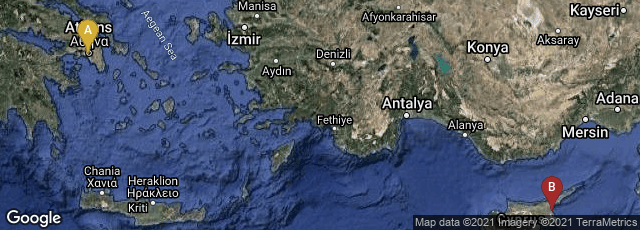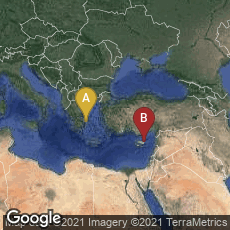

A: Athina, Greece, B: Yeni Boğaziçi
The earliest surviving Athenian decree concerns the status and obligations of men living on Salamis, an ancient Greek city-state on the east coast of Cyprus. The "Salaminian Decree" may be the earliest example of the stoichedon style of epigraphy. This style, named from στοιχηδόν, a Greek adverb meaning "in a row", was the practice of engraving ancient Greek inscriptions in capitals with the letters aligned vertically as well as horizontally. Texts in this form were composed as if in a grid with the same number of letters in each line and each space in the grid filled with a single letter. There were no spaces between words, and no spaces or punctuation between sentences. This was the dominant style of inscription in Athens during the 5th and 4th centuries BCE, and was the preferred style for official state proclamations.
In translation the Greek text reads:
"Decided by the demos. Th[ose in S]alam[is who are cleruch]s
shall be allowed to reside on Salamis [-15- to the Athe]ni-
ans to pay taxes and provide milit[ary service]. [But] what is theirs [on Salamis] shall not
be leased, unless a kinsmen(?) is the lessor. [I]-
f someone should lease it, [the lessee and the] l-
essor shall pay a penalty, each [of them -19-]
to the public treasury. [And the transaction shall be handled by the a]-
rchon, if [not, he shall be held accountable at his euth]y[na. The]-
ir weapons they shall f[urnish themselves]; the cost is th]-
irty dr[achmas. Having been armed]
the archon [shall review their weapons.]
The B[ou]le, [in] the year [- c.11 -]"
"In the aftermath of the reforms of Cleisthenes of 508/7 BCE, the new Athenian democracy sought to establish a presence in the Saronic Gulf against its Peloponnesian (led by Sparta) and Isthmian (led by Corinth) opponents. The nearby island of Aegina and the city-state of Corinth adjacent to the Isthmus, the narrow land that connects mainland Greece to the Peloponnese was controlled by Corinth, both had spheres of interest in the Saronic Gulf. These and other poleis or city-states were active members of the Peloponnesian League, which was led by Sparta and included Athens. The island of Salamis, which Athens had seized from Corinth's neighboring polis Megara in the age of Pisistratus the tyrant ca. 560 BCE (Paus. 1.3.3, 9.6.2), provided the ideal base for such a presence. This, the earliest extant decree of the Cleisthenic demos, addresses the rights and responsibilities of kleruchoi or cleruchs (Athenian citizens dwelling outside of Athens who retain their citizenship) settled by Athens on the island: cleruchs must pay taxes and provide military services to Athens, they may lease the land only to kinsmen (the text here is fragmentary and may refer instead to a dweller) on penalty of a fine, and they must provide their own weapons. Athenian citizens transplanted to Salamis ensured a visible, physical manifestation of Athenian control of the western entrance to the northern Saronic Gulf" (http://www.skidmore.edu/academics/classics/stoa/salamisdecree.html, accessed 04-15-2014.)
"The main evidence for the date of this important decree lies in the letter forms and the arrangement of the text. The stoichedon character ll. 1-6 shows an early stage in the development of the style, which by 485-4 was mature in Athens. . . . The letter forms might be found at any time between c. 520 and c. 480. They are probably cut by the same craftsman as a dedication on the Acropolis of a statue by Hegias . . ., who is presumably the teacher of Pheidas. This does not, however, compel a date after 490, and, if Salamis is the first Athenian cleruchy, the decree should be dated before the cleruchy sent to Chalkis after the Athenian victory of 506. . . . The period immediately following the reforms of Cleisthenes offers a good context. Athens had broken with Sparta; it would have been a sound precaution to establish a permanent garrison on the island which Megara, with Spartan support, might attempt to recover" (Meiggs & Lewis, A Selection of Greek Historical Inscriptions to the End of the Fifth Century B.C. (1969) No. 14, p. 27).
Excavated from the Acropolis, the stone fragments are preserved in the Epigraphic Museum in Athens.